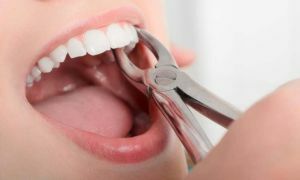 Complex extraction of teeth is a dental manipulation, in which tooth extraction is performed using non-standard tools or other methods.
Complex extraction of teeth is a dental manipulation, in which tooth extraction is performed using non-standard tools or other methods.
The following situations are considered to be a difficult removal:
- tooth extraction with disconnection of divergent or curved roots;
- if the crown is completely missing and the usual forceps designed specifically for this tooth, it can not be removed;
- tooth is removed from the affected bone;
- before the operation the tooth had a seal and its crown under the pressure of the forceps can crack;
- dystopic tooth;
- resorcinol-formalin treatment of the tooth to be removed;
- retinated tooth;
- deletion of the "eight".
Contents of
- When is this operation necessary?
- Preparing for intervention
- What methods are used?
- Problems with retentive teeth
- Extraction stages
- Dystopic tooth - what should I do?
- Operation on the split root of the teeth
When is this surgery necessary?
Removing complex teeth is often the only way to fix a defect. Remove problem teeth according to the following indications:
- soreness of the gums, the appearance of edema near the tooth;
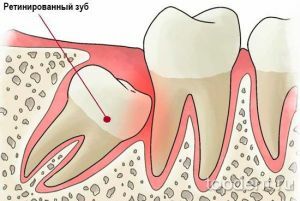
- numbness of a part of the face due to the impact of the tooth on the nerve endings;
- risk of changing the position of adjacent teeth;
- problems with the treatment of neighboring teeth( complications with prosthetics, etc.);
- occurrence of diseases directly provoked by an incorrect position of the tooth.
Doctors refuse patients to remove problem teeth if patients have suffered a hypertensive crisis, suffer from acute cardiac pathologies, have started viral or infectious diseases, have blood diseases.
The removal of atypical teeth can occur with local anesthesia, or under general anesthesia. With local anesthesia, a conductive method is chosen, when the drug is injected along the nerves, blocking the occurrence of painful sensations in patients.
If the patient has intolerance of drugs used in local anesthesia, then surgery is performed under general anesthesia.
These situations are quite rare, as most patients are well tolerated by local anesthetics. In the case of the introduction of general anesthesia, an anesthesiologist is present in the medical team, which determines the dose of anesthesia, which controls the patient's condition and his exit from deep sleep.
Preparing for
intervention To a procedure for complex tooth extraction, doctors prepare patients in advance, as this procedure delivers more discomfort than the extraction of ordinary teeth. Nevertheless, when performing surgery at a high level of complications after removal of complex teeth does not happen.
Before the operation, an X-ray is taken to clarify its localization in the bone and to diagnose the condition of surrounding tissues.
In the presence of an inflammatory process a day before the planned operation, the patient is given antibacterial therapy.
What methods are used?
For the extraction of complex teeth, there are several methods based on the choice of tools, which will be produced by 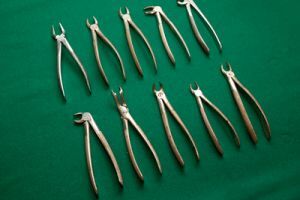 removal:
removal:
- with forceps;
- elevator;
- with the help of a drill.
The choice of technique is also determined depending on the condition of the tooth, its roots, the depth of their deposition in the bone:
- forceps removal is the most gentle method. They use it when the crown of the tooth is not destroyed and it just rises above the gum. Surgical forceps grab the crown at the base and move deeper to the level of the socket. Further the surgeon rotating and rocking movements increases amplitude before rupture of a root of a tooth and an alveoli. At the onset of such a moment the tooth is pulled out from the hole.
- elevator extraction is used if the tooth can not be removed with forceps, or the tooth extends beyond the boundaries of the dentition. The same tool removes teeth on the upper jaw. The principle of the elevator is similar to the wedge. The instrument is deepened into the periodontal gap, after which it begins to be scrolled. Thus, the ligament ruptures and the tooth is squeezed out of the socket.
- The drill removes those teeth that have multiple roots. To assist in the procedure, the roots are separated from the drill, after which each element is removed separately. Also, the drill helps to remove teeth with a resorcinol-formalin seal. This material seals well enough, but it negatively affects the pulp. Under the action of resorcin-formalin, it loses its properties and becomes similar to plastic, releasing simultaneously substances destroying the tooth enamel. Under the force of forceps, the normal crowns are crumbled, so they are removed by a drill. Cutting out the tooth elements with a drill is a long process, if necessary, the surgeon attracts an assistant to the operation.

Elevator Extraction
Problems with the Retained Teeth
Teeth that have not been cut for some reason are called retinas. Most often such a tooth becomes a figure eight, since it erupts later than the rest, when there is no place in the jaw anymore.
Retired wisdom teeth are removed, as they are not involved in the process of chewing food, but are subsequently threatened with inflammation. The peculiarities of removal of retinas are that they are localized in an uncomfortable position and for access to such teeth it is necessary to violate the integrity of the gum.
The average removal of such a tooth takes about an hour, but it can last longer.
Extraction stages
At the beginning of the procedure, an incision is made on the gum covering the tooth. Then a bone is drilled into the bone and the retinas is removed. The next stage is the removal of bone debris, treatment of the wound with an antiseptic and application of sutures.
After surgery, it is recommended to take anti-inflammatory drugs, apply ice to the cheek, so that the blood clot forms more quickly, and the hole does not become the gateway to infection.
Inspection of the well is performed in a week. Complications after removal of the retinas can be manifested in the form of infection in the hole and inflammation of the periosteum, but with a formed blood clot it rarely occurs.
Dystopic tooth - what to do?
 A dystopian is a tooth that is incorrectly positioned relative to its neighbors. He can change the angle of growth, turn around, or even occupy the place of another tooth.
A dystopian is a tooth that is incorrectly positioned relative to its neighbors. He can change the angle of growth, turn around, or even occupy the place of another tooth.
The presence of a problem tooth significantly complicates the location of adjacent teeth, spoils the bite and can affect the appearance of the patient( ugly smile, the appearance of dimples, etc.).
Distressed teeth can appear partially, exposing only a part of the crown, or to rise beneath a layer of the mucous membrane. The third molars are most often dystopic. If such teeth are not removed, they provoke periodontal disease, inflammation, periodontitis.
If the dystopic tooth appeared on the surface of the jaw, then its position can be tried to correct. Correction of the curvature of teeth is possible in patients younger than fifteen years by imposing an orthodontic design. It is necessary to wear it for more than one month, but the procedure justifies the result.
A tooth, which can not be fixed, is to be removed in the same way as the retinum. Complete recovery after surgery occurs in four weeks, complications are rare.
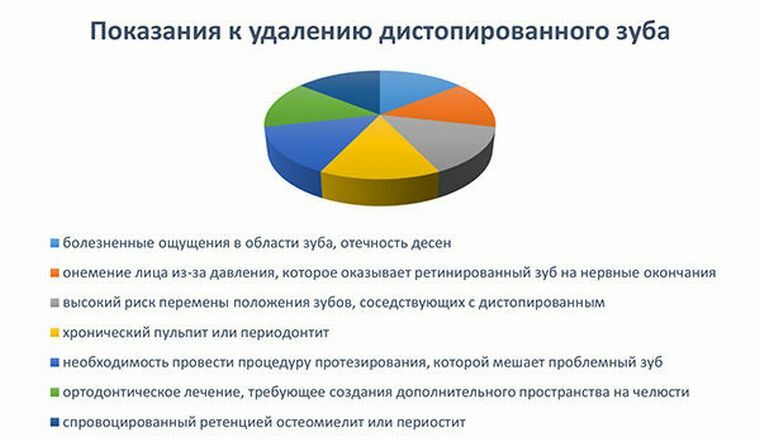
Operation on the severed root of the teeth
A complex tooth extraction with root separation is carried out by an angular elevator. Such an intervention is performed on the teeth of the lower row.
They have two roots that diverge in different directions or very strongly arch inward. To remove the problem tooth, the instrument is firmly fixed in the surgeon's arm, the elevator is placed in the periodontal gap.
The tool handle is pressed into place between the hole and the root, moving inward and displacing the root in the other direction. Simultaneously, the elevator rotates along the axis, pulling its concave part of the root outward. The analogous procedure is carried out with the following root. 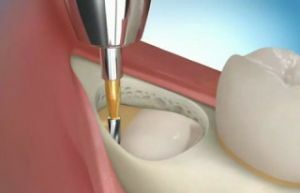
Operations on complex teeth, which due to their anatomical features or pathological localization have difficulties in extraction, are performed by other methods than the removal of ordinary teeth. The choice of technique is determined by a combination of factors - the shape of the tooth, the presence of inflammatory changes in surrounding tissues, the individual features of the structure of the jaw, etc.
Extraction of complex teeth is not an ordinary procedure, but with the proper operation, the rehabilitation process passes quickly.
